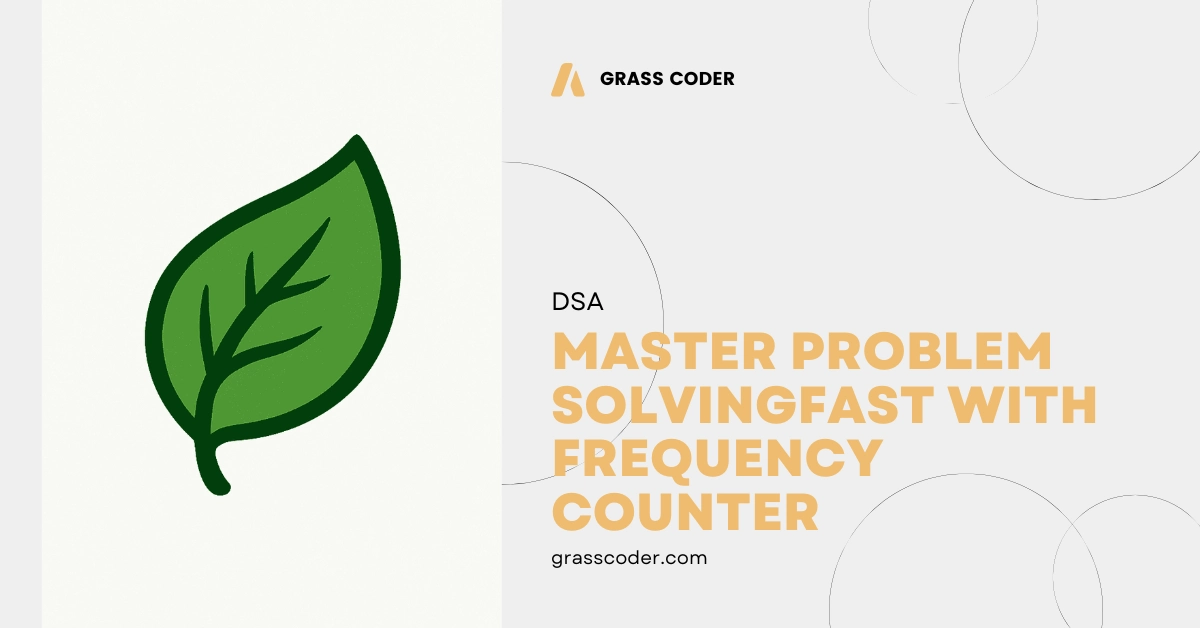Introduction
Have you ever wondered how to efficiently compare arrays or strings to check if they contain the same elements with matching frequencies? The Frequency Counter Pattern is a powerful algorithmic technique that can transform your nested loop nightmares into elegant, linear-time solutions.
This pattern is incredibly useful when you need to:
- Compare multiple datasets for similar values
- Check if strings are anagrams of each other
- Verify if one collection contains all elements of another
- Count occurrences of specific values across datasets
The beauty of this pattern lies in its ability to replace expensive nested loops (O(n²)) with efficient single passes through data (O(n)).
What is the Frequency Counter Pattern?
The Frequency Counter Pattern uses JavaScript objects as hash maps to collect values and track how often they appear. Instead of repeatedly searching through arrays with nested loops, we build a “frequency map” that gives us instant access to count information.
Think of it like creating an inventory system – instead of counting items every time someone asks “how many do we have?”, you maintain a running tally that you can check instantly.
The Problem: Array Comparison
Let’s start with a classic example. Suppose we need to write a function that checks if one array contains the squares of all values from another array, with matching frequencies.
Problem Statement: Write a function checkSquaredValues(numbers, squares) that returns true if every value in the first array has its corresponding squared value in the second array, with the same frequency.
Examples:
checkSquaredValues([2, 3, 4], [4, 9, 16]) // true
checkSquaredValues([1, 2, 2], [1, 4, 4]) // true
checkSquaredValues([1, 2, 3], [1, 9]) // false (missing 4)
checkSquaredValues([1, 1, 2], [1, 4, 4]) // false (frequency mismatch)
The Naive Approach (What NOT to Do)
Before diving into the frequency counter pattern, let’s examine the obvious but inefficient solution:
function checkSquaredValues(numbers, squares) {
// Quick check: arrays must be same length
if (numbers.length !== squares.length) {
return false;
}
// For each number, find its square in the squares array
for (let num of numbers) {
let targetSquare = num * num;
let foundIndex = squares.indexOf(targetSquare);
// If square not found, return false
if (foundIndex === -1) {
return false;
}
// Remove the found square to handle frequency correctly
squares.splice(foundIndex, 1);
}
return true;
}
// Test it
console.log(checkSquaredValues([2, 3, 4], [4, 9, 16])); // true
Why This Approach is Problematic:
- Time Complexity: O(n²) – For each element in the first array,
indexOfsearches through the entire second array - Array Mutation: We’re modifying the input array with
splice, which is generally bad practice - Performance: With 1000 elements, this could require up to 1,000,000 operations!
The Frequency Counter Solution
Now let’s solve the same problem using the frequency counter pattern:
function checkSquaredValues(numbers, squares) {
// Quick validation
if (numbers.length !== squares.length) {
return false;
}
// Build frequency maps for both arrays
let numbersFreq = {};
let squaresFreq = {};
// Count frequencies in first array
for (let value of numbers) {
numbersFreq[value] = (numbersFreq[value] || 0) + 1;
}
// Count frequencies in second array
for (let value of squares) {
squaresFreq[value] = (squaresFreq[value] || 0) + 1;
}
// Compare the frequency maps
for (let key in numbersFreq) {
let squared = key * key;
// Check if squared value exists in second frequency map
if (!(squared in squaresFreq)) {
return false;
}
// Check if frequencies match
if (numbersFreq[key] !== squaresFreq[squared]) {
return false;
}
}
return true;
}
// Test the optimized solution
console.log(checkSquaredValues([2, 3, 4], [4, 9, 16])); // true
console.log(checkSquaredValues([1, 2, 2], [1, 4, 4])); // true
console.log(checkSquaredValues([1, 2, 3], [1, 9])); // false
Let’s trace through this with an example to see how it works:
Input: numbers = [2, 3, 2], squares = [4, 9, 4]
Step 1: Build frequency maps
numbersFreq = { 2: 2, 3: 1 } // 2 appears twice, 3 appears once
squaresFreq = { 4: 2, 9: 1 } // 4 appears twice, 9 appears once
Step 2: Compare frequencies
- For key
2: squared = 4, check ifsquaresFreq[4] === numbersFreq[2]→2 === 2✓ - For key
3: squared = 9, check ifsquaresFreq[9] === numbersFreq[3]→1 === 1✓
Result: true
Performance Analysis
Let’s break down the time complexity:
Frequency Counter Approach:
- First loop: O(n)
- Second loop: O(n)
- Comparison loop: O(n)
- Total: O(3n) = O(n)
Naive Approach:
- Outer loop: n iterations
- Each
indexOfcall: O(n) in worst case - Total: O(n × n) = O(n²)
For an array of 1000 elements:
- Frequency Counter: ~3000 operations
- Naive Approach: ~1,000,000 operations
That’s over 300x faster!
Real-World Example: Anagram Detection
Let’s apply this pattern to another common problem – checking if two strings are anagrams:
function areAnagrams(str1, str2) {
// Convert to lowercase and remove spaces for fair comparison
str1 = str1.toLowerCase().replace(/[^a-z]/g, '');
str2 = str2.toLowerCase().replace(/[^a-z]/g, '');
// Quick length check
if (str1.length !== str2.length) {
return false;
}
// Build frequency map for first string
let letterCount = {};
// Count letters in first string
for (let char of str1) {
letterCount[char] = (letterCount[char] || 0) + 1;
}
// Check against second string
for (let char of str2) {
if (!letterCount[char]) {
return false; // Character not found or count is 0
}
letterCount[char]--; // Decrease count
}
return true;
}
// Test cases
console.log(areAnagrams("listen", "silent")); // true
console.log(areAnagrams("evil", "vile")); // true
console.log(areAnagrams("hello", "bello")); // false
console.log(areAnagrams("The Eyes", "They See")); // true
This approach is particularly elegant because we only need one frequency map. We build it from the first string, then “consume” it while checking the second string.
Advanced Example: Multiple Array Comparison
Let’s tackle a more complex scenario – checking if multiple arrays have the same elements with matching frequencies:
function haveSameElements(arr1, arr2, arr3) {
// All arrays must have same length
if (arr1.length !== arr2.length || arr2.length !== arr3.length) {
return false;
}
// Helper function to build frequency map
function buildFrequencyMap(array) {
let freq = {};
for (let item of array) {
freq[item] = (freq[item] || 0) + 1;
}
return freq;
}
// Helper function to compare frequency maps
function compareFrequencyMaps(map1, map2) {
// Check if they have same number of keys
if (Object.keys(map1).length !== Object.keys(map2).length) {
return false;
}
// Check each key-value pair
for (let key in map1) {
if (map1[key] !== map2[key]) {
return false;
}
}
return true;
}
// Build frequency maps
let freq1 = buildFrequencyMap(arr1);
let freq2 = buildFrequencyMap(arr2);
let freq3 = buildFrequencyMap(arr3);
// Compare all maps
return compareFrequencyMaps(freq1, freq2) &&
compareFrequencyMaps(freq2, freq3);
}
// Test cases
console.log(haveSameElements([1, 2, 3], [3, 1, 2], [2, 3, 1])); // true
console.log(haveSameElements(['a', 'b'], ['b', 'a'], ['a', 'c'])); // false
When to Use the Frequency Counter Pattern
This pattern shines when you encounter problems involving:
- Element counting and comparison
- Anagram detection
- Subset validation
- Duplicate detection
- Character or number frequency analysis
- Data validation across multiple sources
Red flags that suggest using this pattern:
- You’re writing nested loops to compare arrays/strings
- You’re using
indexOforincludesrepeatedly - You need to count occurrences of elements
- The problem involves frequency or distribution of data
Best Practices and Tips
1. Choose the Right Data Structure
// Good: Using object for frequency counting
let freq = {};
for (let item of array) {
freq[item] = (freq[item] || 0) + 1;
}
// Also good: Using Map for complex keys
let freq = new Map();
for (let item of array) {
freq.set(item, (freq.get(item) || 0) + 1);
}
2. Handle Edge Cases
function robustFrequencyCheck(arr1, arr2) {
// Handle null/undefined
if (!arr1 || !arr2) return false;
// Handle different lengths
if (arr1.length !== arr2.length) return false;
// Handle empty arrays
if (arr1.length === 0) return true;
// ... rest of implementation
}
3. Use Helper Functions for Reusability
function createFrequencyMap(array) {
return array.reduce((freq, item) => {
freq[item] = (freq[item] || 0) + 1;
return freq;
}, {});
}
function compareFrequencyMaps(map1, map2) {
const keys1 = Object.keys(map1);
const keys2 = Object.keys(map2);
if (keys1.length !== keys2.length) return false;
return keys1.every(key => map1[key] === map2[key]);
}
Common Pitfalls to Avoid
1. Forgetting Type Coercion
// Problematic: Numbers and strings as keys
let freq = {};
freq[1] = 1; // Key becomes "1"
freq["1"] = 2; // Overwrites the previous value!
// Solution: Be consistent with data types
2. Modifying Input Arrays
// Bad: Mutating input
function badApproach(arr1, arr2) {
// ... modifies arr2 with splice
}
// Good: Working with copies or separate data structures
function goodApproach(arr1, arr2) {
let freq = {};
// ... uses frequency counting instead
}
3. Not Handling Zero Frequencies
// Be careful when decrementing counters
for (let char of str2) {
if (!letterCount[char]) { // This catches both undefined AND 0
return false;
}
letterCount[char]--;
}
Conclusion
The Frequency Counter Pattern is a fundamental technique that every JavaScript developer should master. It transforms complex comparison problems from quadratic time complexity to linear time, making your applications faster and more scalable.
Key takeaways:
- Use objects or Maps to count element frequencies
- Replace nested loops with separate iterations
- Always consider edge cases and input validation
- The pattern works excellently for anagrams, array comparisons, and frequency analysis
By incorporating this pattern into your problem-solving toolkit, you’ll write more efficient code and approach algorithmic challenges with greater confidence. Remember, the goal isn’t just to make code work—it’s to make it work efficiently and elegantly.
Start practicing with simple array comparisons, then gradually tackle more complex scenarios. With time, you’ll instinctively recognize when the frequency counter pattern can save you from performance headaches!
Ready to level up your JavaScript skills? Try implementing the frequency counter pattern in your next project and experience the performance difference firsthand!
Grass Coder





